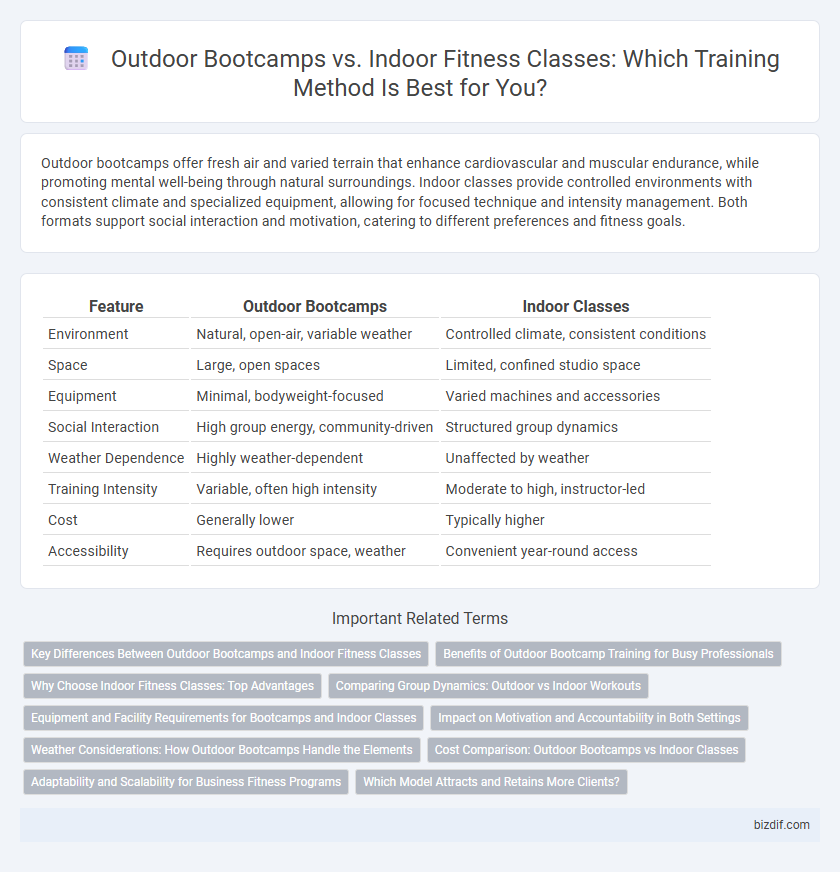Outdoor bootcamps offer fresh air and varied terrain that enhance cardiovascular and muscular endurance, while promoting mental well-being through natural surroundings. Indoor classes provide controlled environments with consistent climate and specialized equipment, allowing for focused technique and intensity management. Both formats support social interaction and motivation, catering to different preferences and fitness goals.
Table of Comparison
| Feature | Outdoor Bootcamps | Indoor Classes |
|---|---|---|
| Environment | Natural, open-air, variable weather | Controlled climate, consistent conditions |
| Space | Large, open spaces | Limited, confined studio space |
| Equipment | Minimal, bodyweight-focused | Varied machines and accessories |
| Social Interaction | High group energy, community-driven | Structured group dynamics |
| Weather Dependence | Highly weather-dependent | Unaffected by weather |
| Training Intensity | Variable, often high intensity | Moderate to high, instructor-led |
| Cost | Generally lower | Typically higher |
| Accessibility | Requires outdoor space, weather | Convenient year-round access |
Key Differences Between Outdoor Bootcamps and Indoor Fitness Classes
Outdoor bootcamps leverage natural terrain and varying weather conditions to enhance cardiovascular and strength training intensity, promoting greater endurance and flexibility. Indoor fitness classes offer controlled environments with specialized equipment and consistent temperature, enabling precise workout programming and reduced injury risk. Outdoor sessions often emphasize group dynamics and functional movements, while indoor classes provide structured routines tailored to specific fitness goals.
Benefits of Outdoor Bootcamp Training for Busy Professionals
Outdoor bootcamp training offers busy professionals a dynamic environment that boosts cardiovascular health and enhances mental clarity through exposure to natural sunlight and fresh air. These sessions provide efficient, full-body workouts that maximize calorie burn and muscle engagement in less time compared to traditional indoor classes. Exercising outdoors also reduces stress levels, increases vitamin D synthesis, and fosters social interaction, supporting overall well-being despite demanding schedules.
Why Choose Indoor Fitness Classes: Top Advantages
Indoor fitness classes offer a controlled environment with consistent temperature and weather protection, ensuring workouts remain uninterrupted year-round. Professional instructors provide personalized guidance, boosting motivation and technique accuracy. Access to a variety of equipment and structured programs maximizes workout efficiency and results.
Comparing Group Dynamics: Outdoor vs Indoor Workouts
Outdoor bootcamps foster a dynamic group energy fueled by fresh air, varied terrain, and natural elements, boosting motivation and camaraderie among participants. Indoor classes offer controlled environments with consistent lighting, temperature, and equipment, creating focused group dynamics conducive to structured routines and skill progression. Both settings facilitate social interaction, but outdoor workouts often encourage spontaneity and adaptability, while indoor sessions emphasize precision and stability in group exercises.
Equipment and Facility Requirements for Bootcamps and Indoor Classes
Outdoor bootcamps require minimal equipment such as resistance bands, kettlebells, and bodyweight tools, relying heavily on open spaces like parks or tracks, which reduces facility costs and enhances versatility. Indoor classes depend on specialized equipment including treadmills, stationary bikes, dumbbells, and weight machines, necessitating a well-equipped gym environment with controlled climate and safety features. The choice between bootcamps and indoor classes hinges on accessibility to outdoor spaces versus the availability of comprehensive indoor fitness facilities.
Impact on Motivation and Accountability in Both Settings
Outdoor bootcamps boost motivation through fresh air, natural surroundings, and dynamic group energy, fostering a sense of adventure and community. Indoor classes offer structured environments with clear routines, enhancing accountability via scheduled sessions and direct instructor supervision. Both settings leverage social support and goal-setting to maintain commitment, but outdoor bootcamps often inspire higher enthusiasm, while indoor classes provide consistent framework for progress tracking.
Weather Considerations: How Outdoor Bootcamps Handle the Elements
Outdoor bootcamps adapt to diverse weather conditions by incorporating flexible workout plans that accommodate rain, heat, and wind, ensuring safety and effectiveness. Instructors often modify intensity or switch to sheltered areas during extreme weather, maintaining participant engagement and minimizing risk. This adaptability contrasts with indoor classes, which provide controlled environments but lack exposure to natural elements that can enhance stamina and mental resilience.
Cost Comparison: Outdoor Bootcamps vs Indoor Classes
Outdoor bootcamps typically offer lower costs due to minimal facility expenses and group-based sessions, often charging between $5 to $20 per class. Indoor classes, requiring gym rentals or specialized equipment, usually range from $15 to $50 per session, reflecting higher overhead costs. Choosing outdoor bootcamps can provide an affordable fitness option without sacrificing structured training quality.
Adaptability and Scalability for Business Fitness Programs
Outdoor bootcamps offer high adaptability by utilizing varied natural terrains and weather conditions, which challenge participants and enhance functional fitness. Indoor classes provide scalability through controlled environments and customizable equipment setups, allowing consistent programming and accommodating diverse group sizes year-round. Businesses seeking flexible, scalable fitness solutions often integrate both formats to optimize participant engagement and operational efficiency.
Which Model Attracts and Retains More Clients?
Outdoor bootcamps attract and retain more clients by offering dynamic, fresh air environments that enhance motivation and social interaction, key factors in sustained engagement. Indoor classes appeal to clients seeking controlled temperature, professional equipment, and structured routines, catering to consistency and convenience. Data shows outdoor bootcamps experience higher participant retention due to the varied workout settings and community-driven atmosphere.
Outdoor Bootcamps vs Indoor Classes Infographic

 bizdif.com
bizdif.com